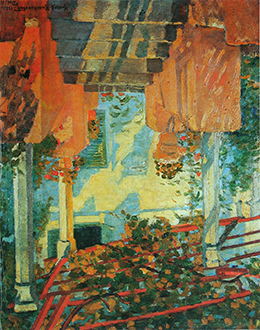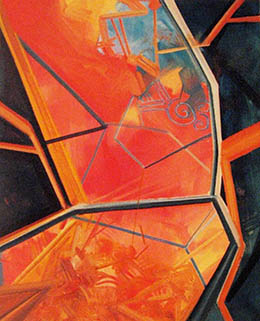
M. Milovanović, Red Terrace, oil/canvas, 1920.
Some visitors to the 1994 show entitled Art of Serbian Vanguard at the Belgrade Museum of Contemporary Art were surprised to find an unexpectedly fresh abstract painting within a predominantly figurative exhibition set. However, it was not an abstract composition of some mysterious artist, but a painting Red Terrace by Milan Milovanović, mistakenly hung upside-down. Unwittingly connecting to the trendy exhibiting practices of unconventional and daring museum sets, the organizers of this exhibition offered the art lovers a unique privilege to experience a well-known artwork in a different context. Indeed, Red Terrace viewed at 180 degrees looked excellent, directing the visitors’ thoughts to various directions. It was quite difficult to recognize it as the overturned realist painting – an experience similar to the famous one of Kandinsky, which allegedly initiated the grand tradition of lyrical abstraction. Nevertheless, the paintings that function equally well at different angles are rare and some minimal works (e.g. those of Malevich, Newman, Reinhardt, or Stella) which might initially be considered as candidates are actually quite restrictive in that matter. The intended spatial diversity requires a complex set of techniques and reasoning, far more serious than visual trickery that holds doubtful reputation in art.
That is why Goran Ostojić’s new art project initiates a number of questions. What is the motivation for his series of paintings aimed to be viewed meaningfully at any oblique angle of orientation? An adventurous spirit or a need for affirmation? A superficial intellectualizing or authentic visual thinking? A self-conscious questioning of the art tradition or a self-indulgence? A ripe authorship or an infantile dream of omnipotence. An utopist project or a mystification?

G. Ostojić, eta1,et2,eta3,et4, oil/canvas, 2000.
Goran Ostojić faces these questions with eagerness specific to his generation of artists, who studied art in Belgrade in the early Nineties. That period was characterized by the rapid decline of general interest in art, and consequently with a recession of institutional, material and moral support, which was especially harsh coming immediately after the Eighties that were a sort of ‘golden age’ in that matter. The Serbian citizens, occupied with numerous, much more essential existential issues, sanely determined that art was the last thing they needed. The artists, whose identity has allways been primarily dependent on social response, cynically concluded the same.
Their disappointment and bitterness were, of course, naively needless since one of the most intriguing conditions of art is exactly that, in a wider context, it is never high on a social agenda. An average person, immersed in her/his contemporaneity, does not realy need art, particularly of the kind that annoys, undermines the habits and denies the common sense. In both social and individual context, art is a sort of disturbance or a disease by which it is often metaphorized, while the audience, heavily ‘protected’ by cultural conditioning, intuitively avoids to experience it directly, without some kind of intermediation. As a device for individual transformation, art has therefore always been smuggled behind the decorative, narrative, reflexive, obscene or other qualities, with redundancy as its key challenge expressed in a question: Why does this exist? Inducing a certain, often unconscious, interest, this question is also a bait, a virus that spreads the plague of art. Can the tensions in Goran Ostojić’s paintings catalyze it?
Goran Ostojić, Paintings, exhibition catalogue, Paleta Gallery, Cultural Center, Belgrade, 2000.